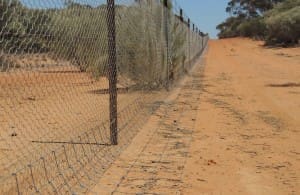Australia’s national wild dog coordinator Greg Mifsud admits to feeling disappointed that many northern sheep producers now feel that the only way they can stay in the industry is to build expensive predator-proof fences around their properties.
While he agrees that predator fencing will help to solve the dog problem for affected producers, he says it is a move that has been forced out of pure desperation because so many other landholders refuse to participate in dog control efforts.
Despite having better than ever support for dog control programs at Government and industry leadership level, a winnable fight is still being lost purely through a lack of community spirit and landholder cooperation.
In the process netting fences are suddenly reappearing on property boundaries in areas where they haven’t been seen in years.
Once when sheep dominated the northern landscape as well as the south it was a condition of pastoral leases that boundaries be fenced with dog-and marsupial proof netting.
For many years this requirement ensured an effective network of barriers was in place to prevent wild dogs from roaming the landscape.
However the wool industry downturn from the early 1990s and a lack of viable sheep production alternatives at the time saw many northern sheep properties gradually turned over to cattle.
Old netting fences were bulldozed and replaced with strands of plain and barbed wire and fewer sheep properties meant there were fewer landholders in each district prepared to participate in dog control efforts.
As the previous barriers to dog dispersal were gradually removed and more and more gaps in control programs appeared, dogs were again able to freely move across the landscape and re-colonise areas that had not seen dogs for years.
As the number of sheep properties declined those that remained became bigger and bigger targets for the growing cohorts of dogs, and over time cattle producers also began to feel the impact through increases in calf losses.
Mr Mifsud said many sheep producers have now simply lost faith in the ability of broader control campaigns to protect their flocks and now see little choice but to build predator-proof boundary fences as a last resort.
At a typical cost of a $4000 to $6000 per kilometre to build, it is an expensive exercise, albeit one that comes with significant benefits – greater enterprise options for their property, greater control over total grazing pressure on their land and in turn a cost-effective development investment that improves the overall value of their property.
Some property owners have invested in fencing their own boundaries, while others have shared costs with neighbouring landholders and built fences around clusters of multiple properties.
One cluster at Morven for example comprises more than 40 individual properties, while another at Tambo involves nine.
While producers have often resisted the idea of co-investing with other producers across boundaries in the past, typically out of concern that others may not pay their share or fulfill their maintenance obligations, so serious has the dog problem become there is now plenty of motivation to cooperate.
For many it comes down simply to the difference between being able to stay in sheep or not.
Mr Mifsud cited the experience of one landholder near Charleville who finished building a new predator fence around his boundary three years ago. He has since cleaned all wild dogs out of the property and is celebrating a return to 100 percent lambings in a low rainfall area for the first time in many years.
Check fences versus cluster fences
While many producers are forming clusters, in Central Western Queensland another group of producers is also pushing for their local Governments and the State Government to support their proposal to build a 1400km long “check fence” to encircle eight million acres across four shires in the region.
The proposal has secured the support of one of the four local councils so far, the Barcoo Shire which surrounds Windorah, Jundah and Stonehenge. However the proposal suffered a setback last month when the Barcaldine Regional Council voted to support a local cluster fencing model instead. The two remaining regional councils in the proposal area – Tambo-Blackall and Longreach – are yet to make a decision, so the project’s future remains uncertain.
Mr Mifsud said that in his view, predator-fencing was clearly part of the solution, but “we have to be smart about how we use it”.
He believes the industry will be better served by encouraging properties to form into fencing clusters using the barrier fence as the backbone.
“To me, when you have got a multi million dollar barrier fence being maintained by Government, and it is in the best knick it has ever been in, it would seem silly not to utilise that as the backbone of your efforts,” he said.
“My concern with the check fence proposal is that basically all we’re going to do is encircle another population of dogs, and you still are going to have a whole range of people inside that fence that we can’t get to participate (in control efforts) now.”
He said cluster cells around groups of four to five properties emanating off the barrier fence would provide a “spiderweb of barriers” to stop dogs from moving, and allowing dogs to be cleaned out of each cell.
“So you do four properties here, the next four build off that and all of a sudden you end up with that honey comb effect, using the barrier fence as your backbone,” he said.
“And there is no reason you can’t go both ways, north and south of the exisiting barrier fence, which would be far more effective.”
Electric fencing should play a role
Mr Mifsud said he also believed new generation electric fencing had significant potential to provide a cost-effective means of keeping wild dogs at bay.
He said the technology had come a long way since the days when electric fencing was first introduced and struggled to work effectively across long distances. Modern electric fencing technology had been proven to work to very effectively to control wild dogs in eastern Victoria where slopes and gullies made it too difficult to use netting.
“The cost is affordable, plus you now have remote systems that can isolate and identify breakdowns.
“In some of that Mitchell grass country where it is flat as a tack, grading a line alongside an existing fence and putting in outriggers is likely to be very effective I would think.”



Gee I no some doggers are on $500 a dog I could do it long term for $100a dog . I trapped 500 dogs last year in cattle country after baiting it’s bloody hard work but no bounty system in our shire . Fully equipt just message if I can help out thank you.
And if the dogs aren’t taking baits as a lot of older 1 don’t and spooked by unskilled trappers find pads roads ect where there traveling find a step down or up point place stick over pad then both sides of stick where dog steps put some honey laced with strychnine there very light sprinkle of light sieved dirt over it not much when dogs step in it they lick there pads clean ull get the most cunning of dogs every time .
Yes fencing is the answer then all property’s need to hire a dogger long term . Keep au trapping baiting n fence maitnence long term is the answer then sheep will be sustainable again that’s the key .
We have fenced here at Blackall,with our neighbours, to enclose 50k acres. We finished the job for about $5/acre.
When the material became available, it was a no-brainer. We started in 2010 and finished 2014. The dogs had not got here, in 2010 like they are now, so we had time to erect a fence.
Just the lambmarking alone 120% compared with under 30% for sheep stations with out a fence.
Wilddogs are not taking baits as they have in the past, I put it down to the collapse of the roo shooting industry, when sport shoe manufacturers stop using roo leather, all shortly after the PETA attack on the merino industry over mulseing.
The increase in roo numbers has really sky rocketed, it is just too easy for a wilddog to it fresh meat with the thrill of catching it. Compare that to a dried sausage bait or dried meat bait dropped from a plane.
Trappers will ask graziers too drop baits first, as this will help him, to stop catching foxes, and be cheaper for the grazier for the baits to kill a lazy wilddog. Trappers are on $500/ wildog, which is about the price of a new born calf. That can add up quickly as a expensive exercise for the grazier.
A trapping school was run locally, and a trapper caught 60 dogs, over 10k acres in 14 days. Thirteen people attended over the time, so you can imagine how slow the trapper was moving, imagine what the number would be if he could move at a pace unincumbered with people.
The wheel has not been re-invented here, fencing and trapping was how it was done 80 years ago. We have added 1080, for a three prong attack at wilddogs.
The Qld government purchased a container of 1080 in the early seventies. that has run out now, and they are not replacing it, so the grazier will have to buy 1080, we can only imagine how much less land will be baited now, with the grazier paying for a product that always been available for free.
I sometimes wonder what the crystal ball has in for the future, for all the small animal industries of Queenland.
Good hunting and goodluck grazing!